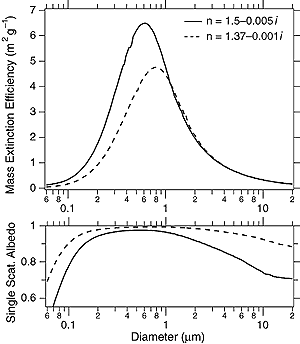|

Figure 5.1: Extinction efficiency (per unit total aerosol mass)
and single scattering albedo of aerosols. The calculations are integrated
over a typical solar pectrum rather than using a single wavelength. Aerosols
with diameters between about 0.1 and 2 µm scatter the most light
per unit mass. Coarse mode aerosols (i.e., those larger than accumulation
mode) have a smaller single scattering albedo even if they are made of
the same material (i.e., refractive index) as accumula-tion mode aerosols.
If the refractive index 1.37 0.001i is viewed as that of a hydrated
aerosol then the curve represents the wet extinction efficiency. The dry
extinction efficiency would be larger and shifted to slightly smaller
diameters.
|
5.1.2 Aerosol Properties Relevant to Radiative Forcing
The radiatively important properties of atmospheric aerosols (both direct and
indirect) are determined at the most fundamental level by the aerosol composition
and size distribution. However, for purposes of the direct radiative forcing
calculation and for assessment of uncertainties, these properties can be subsumed
into a small set of parameters. Knowledge of a set of four quantities as a function
of wavelength is necessary to translate aerosol burdens into first aerosol optical
depths, and then a radiative perturbation: the mass light-scattering efficiency
asp, the functional dependence of light-scattering on relative humidity
f(RH), the single-scattering albedo wo, and the asymmetry parameter
g (cf., Charlson et al., 1992; Penner et al., 1994a).
Light scattering by aerosols is measurable as well as calculable from measured
aerosol size and composition. This permits comparisons, called closure studies,
of the different measurements for consistency. An example is the comparison
of the derived optical depth with directly measured or inferred optical depths
from sunphotometers or satellite radiometers. Indeed, various sorts of closure
studies have been successfully conducted and lend added credibility to the measurements
of the individual quantities (e.g., McMurry et al., 1996; Clarke et al., 1996;
Hegg et al., 1997; Quinn and Coffman, 1998; Wenny et al., 1998; Raes et al.,
2000). Closure studies can also provide objective estimates of the uncertainty
in calculating radiative quantities such as optical depth.
Aerosols in the accumulation mode, i.e., those with dry diameters between 0.1
and 1 mm (Schwartz, 1996) are of most importance. These aerosols can hydrate
to diameters between 0.1 and 2 mm where their mass extinction efficiency is
largest (see Figure 5.1). Accumulation mode aerosols not
only have high scattering efficiency, they also have the longest atmospheric
lifetime: smaller particles coagulate more quickly while nucleation to cloud
drops or impaction onto the surface removes larger particles efficiently. Accumulation
mode aerosols form the majority of cloud condensation nuclei (CCN). Hence, anthropogenic
aerosol perturbations such as sulphur emissions have the greatest climate impact
when, as is often the case, they produce or affect accumulation mode aerosols
(Jones et al., 1994).
The direct radiative effect of aerosols is also very sensitive to the single
scattering albedo wo. For example, a change
in wo from 0.9 to 0.8 can often change
the sign of the direct effect, depending on the albedo of the underlying surface
and the altitude of the aerosols (Hansen et al., 1997). Unfortunately, it is
difficult to measure wo accurately. The
mass of black carbon on a filter can be converted to light absorption, but the
conversion depends on the size and mixing state of the black carbon with the
rest of the aerosols. The mass measurements are themselves difficult, as discussed
in Section 5.2.2.4. Aerosol light absorption can also
be measured as the difference in light extinction and scattering. Very careful
calibrations are required because the absorption is often a difference between
two large numbers. As discussed in Section 5.2.4, it is
difficult to retrieve wo from satellite
data. Well-calibrated sunphotometers can derive wo
by comparing light scattering measured away from the Sun with direct Sun extinction
measurements (Dubovik et al., 1998).
Some encouraging comparisons have been made between different techniques for
measurements of wo and related quantities.
Direct measurements of light absorption near Denver, Colorado using photo-acoustic
spectroscopy were highly correlated with a filter technique (Moosmüller
et al., 1998). However, these results also pointed to a possible strong wavelength
dependence in the light absorption. An airborne comparison of six techniques
(extinction cell, three filter techniques, irradiance measurements, and black
carbon mass by thermal evolution) in biomass burning plumes and hazes was reported
by Reid et al. (1998a). Regional averages of wo derived from all techniques
except thermal evolution agreed within about 0.02 (wo
is dimensionless), but individual data points were only moderately correlated
(regression coefficient values of about 0.6).
Continues on next page
